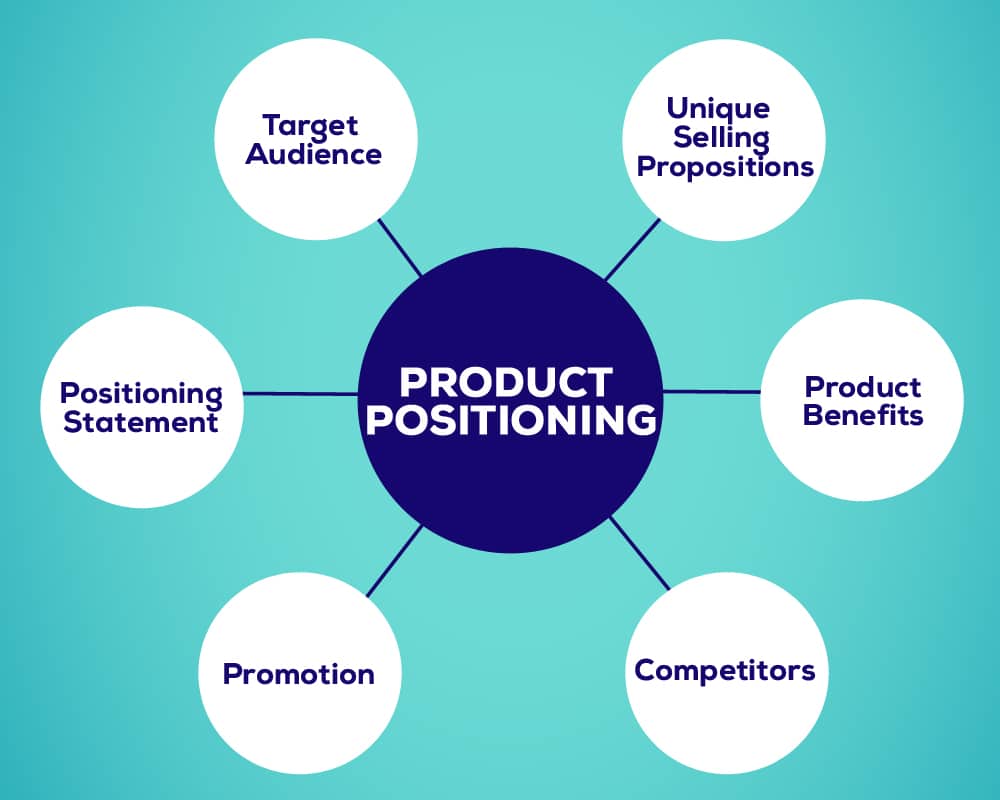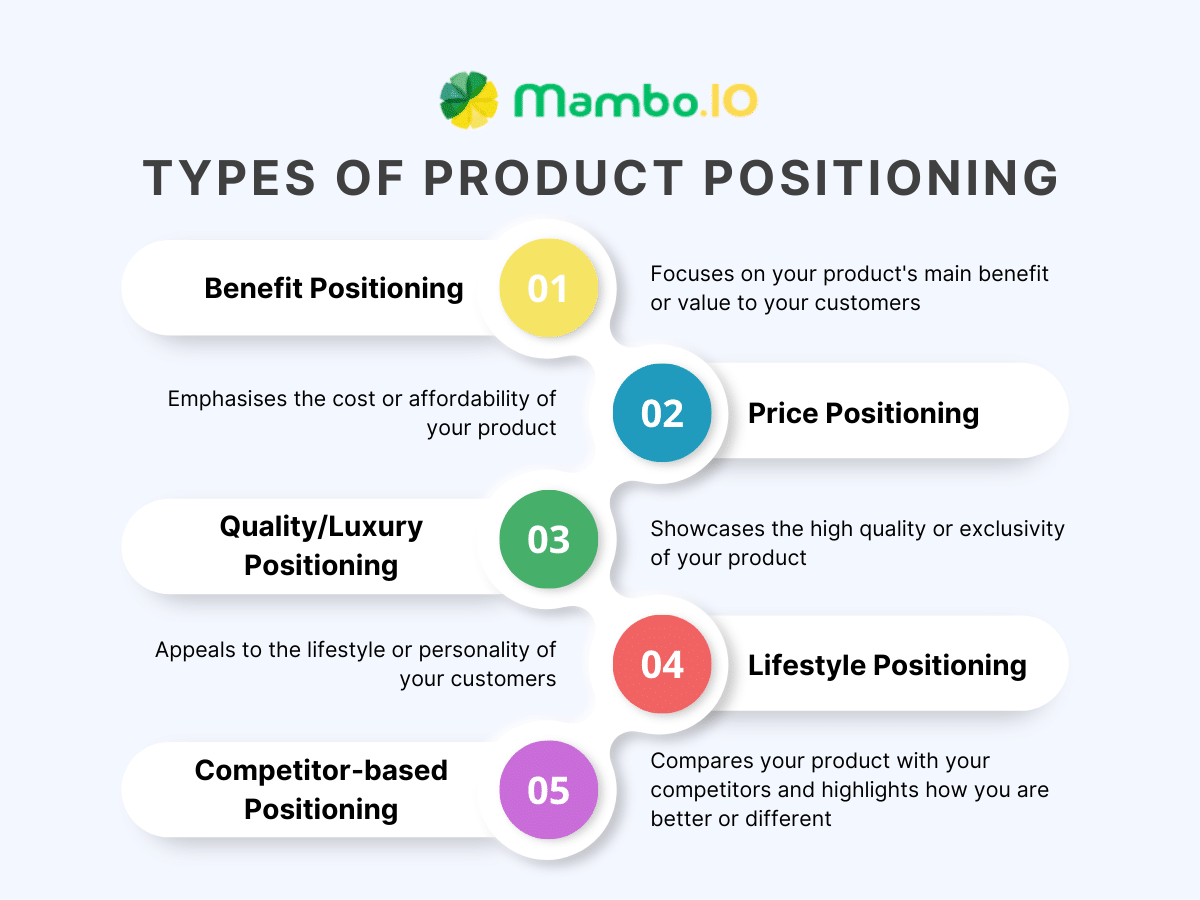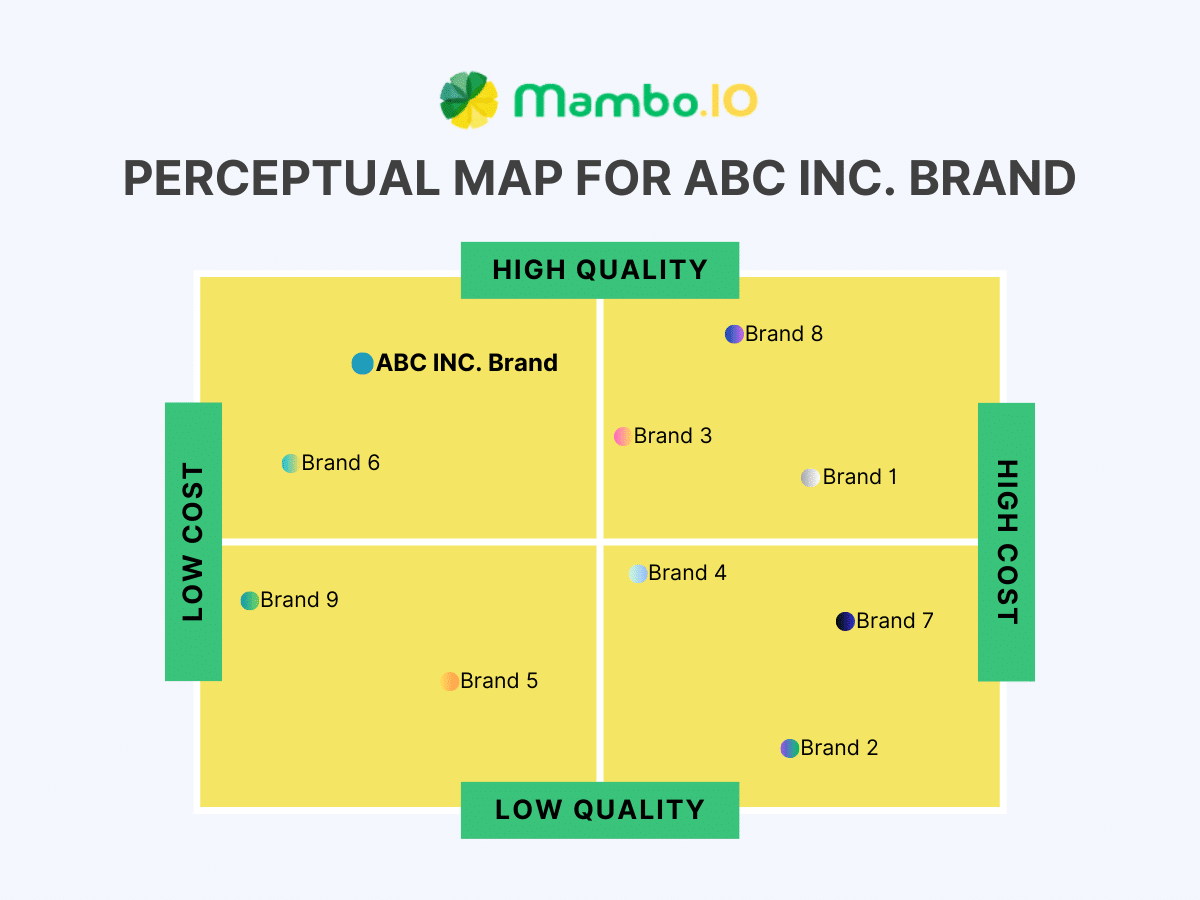Product Positioning: How To Stand Out and Win in a Crowded Market
Product positioning determines your product’s emotional and psychological benefits for your target audience. It goes beyond your product’s physical features and functionality.
Product managers who want to create a strong brand identity and differentiate themselves from the competition must develop product positioning strategies.
In today’s changing market, you must position your product effectively and use your product positioning strategy in different situations to attract and retain customers.
This article will teach you what product positioning is, why you need it, and how to do it.
Table of Contents
- What is product positioning?
- Why is product positioning important?
- Developing your product positioning statement
- Successful product positioning statements
- Types of product positioning
- What are good product positioning examples?
- Challenges in product positioning
- Strategies for effective product positioning
- Conclusion
- Machine Learning In Finance: 12 Essential Applications
- How To Create Interactive Compliance Training For Bank Employees
- How Fintech Apps Are Using Gamification To Increase User Engagement
- Top Gamification Companies for Employee & Customer Engagement
What is product positioning?
Product positioning helps you establish how your customers perceive your product’s role in the market relative to its competitors. It helps you communicate your unique value proposition and differentiate your product from others.

Source: DesignerPeople
Product positioning emerged in the advertising industry in the early 20th century. Still, it was popularised by marketing experts Al Ries and Jack Trout in their 1981 book Positioning: The Battle for Your Mind (1981).
They defined positioning as the perception that the target market has of a company, product, or service compared to its competitors in the same category.
Ries and Trout gave some valuable advice on effectively positioning your product. They said that:
- The first step in any positioning programme is to look inside the prospect’s mind.
- If you didn’t get into your prospect’s mind first (personally, politically, or corporately), then you have a positioning problem.
- Once you own a word in your mind, you must use it or lose it.
Therefore, to position your product effectively, you must:
- Simplify your message and focus on key benefits or attributes.
- Find a unique or distinctive position that sets you apart from your competitors.
- Keep at it year after year and maintain consistency in your positioning strategy.
Why is product positioning important?
Positioning is the third key in the STP Marketing Model, which stands for segmentation, targeting and positioning. After identifying your market segments and selecting your target customers, you must position your product or service. This appeals to the target audience and differentiates you from your competitors.

Source: Smart Insights
Product positioning is important because it helps you:
- Attract and retain your ideal customers who are looking for a solution to their specific problem or need
- Increase customer loyalty and satisfaction by delivering on your promise and exceeding their expectations
- Build a strong business identity and reputation that reflects your core values and vision
- Gain a competitive edge and increase your market share by offering something different or better than your rivals
- Increase your profitability and growth by charging a premium price for your superior product or service
Therefore, product positioning is a vital strategy for any business that wants to succeed in today’s crowded and competitive marketplace. You can create a lasting impression by clearly defining and communicating your unique value proposition.
This will also help your target audience to choose your product over others.
Developing your product positioning statement
A defined product positioning statement is a concise and clear statement that summarises how you want your customers to perceive your product. It should include four key elements, also the four essential components of a positioning statement.
What are the four elements of product positioning?
#1. Identifying the target market
This element defines your ideal customers based on their demographics, psychographics, needs, and pain points. This target audience represents your brand’s most fervent users and those who will most benefit from your product.
Determining your potential customers into groups is necessary to find your target market. You should base it on various criteria such as demographics, psychographics, geographic, behavioural, or needs-based.
You can use tools like market research, segmentation matrix, or customer profile template to help you with this task.
#2. Analysing competition
This element describes who your direct and indirect competitors are, their position, and their strengths and weaknesses. This frame of reference (FOR) shows the category in which your product competes and gives it relevance to your customers.
To analyse your competition, you must conduct a competitive analysis that involves collecting and evaluating information about your competitors’ products. This includes prices, promotions, distribution channels, strengths, weaknesses, opportunities, and threats.
You can use tools like SWOT analysis, competitive matrix, or perceptual map to help you with this task.
#3. Determining a unique selling proposition
This element highlights what makes your product different or better than your competitors. It emphasises the benefits and features you offer and how you solve your customers’ problems or satisfy their needs.
Your product has a benefit or point of difference (POD) makes it stand out.
Finding out what product features set you apart is an advantage. You can link these benefits to your target market’s needs and pain points.
You can use tools like a feature-benefit matrix, value proposition canvas, or lean canvas to help you with this task.
#4. Creating a positioning statement
With a main message and evidence, you communicate how you want your customers to think and feel about your product. This element persuades your customers that your product keeps its promise.
You need to combine the target market elements, competition, and unique selling proposition. Craft a brief and clear statement that shows how you want your customers to see your product.
Here are some product positioning statement templates that you can use:
- For[target market], [product name] is a [product category] that [unique selling proposition]. It helps them [benefit] by [how it works].
- When it comes to [unique selling proposition], no other [product category] can match [product name]. It is the best choice for [target market] because it [how it works].
- [Product name] is the [product category] that [unique selling proposition] for [target market]. It [how it works] to [benefit].This product was created for [target market] who [need/want] [emotion or solution]. Our [product name] is a [product category/solution] that solves this by [features/benefits].
- The only [product category] that [unique selling proposition] is [product name]. It is made for [target market] who [need/want] [emotion or solution].It works by [how it works] to [benefit]. Whether you are [target market], you can trust [product name] to deliver on its promise.
- If you are [target market] who [needs/want] [emotion or solution], you will appreciate [product name]. It is a [product category] that [unique selling proposition] and [how it works] to [benefit]. [Product name] is customised for your needs and desires.
Successful product positioning statements
Many companies base their marketing strategies on their positioning statements. These statements effectively communicate their value proposition to their target customers. Here are some successful companies that have done so:
#1. Slack
Product Positioning Statement:
“Slack is the collaboration hub that brings together the right people, information, and tools to get work done.
From Fortune 100 companies to corner markets, millions worldwide use Slack to connect their teams, unify their systems, and drive their business forward.”
What makes this product positioning statement effective?
This product positioning statement clearly defines what Slack is, what it does, and why it is better than other tools. How many people use Slack and how different customer segments can benefit from it are also shown.
It communicates the value and benefits of Slack in a simple and catchy way.
#2. Amazon
Product Positioning Statement:
“Amazon differentiates itself from other online retailers with its dedication to the customer, enthusiasm for innovation, and exceptional operational performance.”
Amazon is a one-stop online shopping site that offers fast shipping for consumers who want to purchase a wide range of products online.
What makes this product positioning statement effective?
This product positioning statement is effective because it describes who Amazon serves, what Amazon offers, and how Amazon differs from other online retailers.
It also highlights Amazon’s core values and strengths, making it a trusted and reliable brand. It conveys the convenience and variety of Amazon concisely and appealingly.
Types of product positioning

You can use various product positioning strategies to draw attention to different features of your product. Some of its types include the following:
#1. Benefit positioning
This type focuses on your product’s main benefit or value to your customers.
Example: Volvo is a car brand that offers safety and reliability.
#2. Price positioning
It emphasises the cost or affordability of your product.
Example: Walmart positions itself as a retailer that offers everyday low prices
#3. The quality or luxury positioning
This type showcases the high quality or exclusivity of your product.
Example: Rolex positions itself as a watch brand that offers prestige and craftsmanship.
#4. Lifestyle positioning
It appeals to the lifestyle or personality of your customers.
Example: Red Bull positions itself as an energy drink that gives adventurous and active people wings.
#5. Competitor-based positioning
This type compares your product with your competitors and highlights how you are better or different.
Example: Avis positions itself as a car rental company that tries harder than its competitors.
Your target market, competitive landscape, brand values, and product vision determine the type of product positioning that you choose. You should pick the type that fits your product well and appeals to your customers.
A perceptual map is a tool that you can use to choose the right type of product positioning. This visual represents how customers perceive different products or brands in a market based on two or more dimensions.
For example, you can plot products based on price, quality, lifestyle, and personality.

Here is an example of a perceptual map for different car brands based on their perceived price and style:

Source: Hocmarketing.org
As you can see, car brands occupy different positions on the map. A perceptual map can help you identify the gaps or opportunities in the market where you can position your product.
It can also help you avoid crowded or competitive areas where you need help standing out.
What are good product positioning examples?
Here are some examples of products that have achieved successful product positioning in their markets:
#1. Apple
Apple positions itself towards creative individuals by leveraging its reputation as an innovative and design-oriented company. It also emphasises the performance, simplicity, and elegance of its products.
This is an example of quality or luxury positioning that aligns with the company’s brand values and product vision.
#2. Nike
Nike positions itself as a brand for elite athletes. From its tagline, “Just Do It,” which models its products after famous sports stars, to its products highlighting its technological superiority.
Nike inspires its customers to achieve their goals and dreams. This example of lifestyle positioning reflects the company’s target market and unique selling proposition.
#3. Lush
Lush is famous for its natural and handmade cosmetics and bath products. The brand claims to be ethical and eco-friendly and to support various causes like animal rights, human rights, and environmental conservation.
Its colourful and fragrant products also create a unique sensory experience for its customers. This example of benefit positioning differentiates the company from its competitors and appeals to its customer’s values.
These examples show how different products use different types of product positioning to create a distinct image in their customers’ minds. They also show how they align their product positioning with their brand identity, product vision, target market, and unique selling proposition.
Challenges in product positioning
Product positioning requires constant research, analysis, testing, and refinement. The challenges that you may face in product positioning are:
-
Changing customer preferences and expectations
Customers’ preferences may change due to trends, technology, culture, and the economy. You must keep up with these changes and adapt your product positioning accordingly.
-
Increasing competition and market saturation
More products are entering the market every day. Finding a niche or a gap for your product’s positioning is essential to making it stand out.
-
Limited resources and budget
Time, money, and effort are essential for product positioning. Business activities require investment in market research, product development, marketing, and distribution. Balancing the quality and quantity of your product positioning efforts is also necessary.
To overcome these challenges, you must clearly understand your customers, competitors, product, position, and message. Monitoring market feedback and measuring the effectiveness of your product positioning is also necessary.
Using data and analytics to conduct market research and inform product positioning decisions is one way to overcome these challenges. Data and analytics can help you:
- Understand your customers’ behaviour, preferences, satisfaction, and loyalty.
- Identify your competitors’ strengths, weaknesses, opportunities, and threats.
- Evaluate your product’s performance, features, benefits, and value proposition.
- Test your product positioning statement, message, and channels.
- Track your product positioning results, outcomes, and impact.
You can use data and analytics to support your decisions about your product positioning with more evidence. The data can also give you insights to tweak your product positioning strategies.
Strategies for effective product positioning
To achieve effective product positioning, you can follow these strategies:
#1. Know your customers
Having complete knowledge of your customers is the most essential and initial part of this.
You can use various methods like surveys, interviews, focus groups, and personas. It helps to understand their problems, needs, desires, motivations, behaviours, and preferences and gather customer insights.
#2. Understand your competitors
Knowing and understanding your competitors well is the second step in making a strategy.
So, do you know who your customers are? What do they offer? How do they position themselves? And how do they perform? SWOT analysis, competitive matrix, and perceptual map tools can help you analyse your competitive landscape.
#3. Define your product
The third strategy is to know your product thoroughly. You must define your product based on what it can do, how it works, and why it matters.
You also need to recognise its features, benefits, and value proposition. You can use tools such as the feature-benefit matrix, the value proposition canvas, and the lean canvas to describe your product.
#4. Align your position
The fourth strategy is to know your position. You need to craft a compelling and consistent product positioning statement that summarises how you want your customers to perceive your product.
You must also align your position with your brand’s identity and vision. You can use tools such as a positioning statement template, a brand pyramid, and a vision statement to create your position.
#5. Tailor your message
The fifth strategy is to know your message effectively. You must communicate your product positioning statement to your target audience through various channels and mediums.
You also need to tailor your message to different segments and stages of the customer journey. You can use tools such as the marketing mix, customer journey map, and AIDA model to deliver your message.
Conclusion
Product positioning is vital for product managers who want to create a strong brand identity and stand out. It helps you communicate your unique value proposition and differentiate your product from others.
To develop an effective product positioning strategy, you must know your customers, competitors, product, position, and message. You must also overcome the challenges and apply the strategies for effective product marketing messages and positioning.
If you want to learn more about product positioning strategies and other essential skills for product managers, you should check out Mambo.
Download your free
“Gamification Guide”
Get your PDF now and start transforming your approach to digital engagement!
Latest Posts
Machine Learning In Finance: 12 Essential Applications
The impact of machine learning on finance is significant. Thanks to this technology, financial institutions are now equipped to make efficient decisions. Through the analysis of data sets, machine learning […]
How To Create Interactive Compliance Training For Bank Employees
Banking compliance training isn’t just another task. It’s the stage where everything else performs. Banks must navigate a myriad of regulations and laws. After all, this is a trust-driven, high-stakes […]
How Fintech Apps Are Using Gamification To Increase User Engagement
Discover how gamification in fintech is revolutionizing financial engagement, making banking fun & boosting user loyalty.





